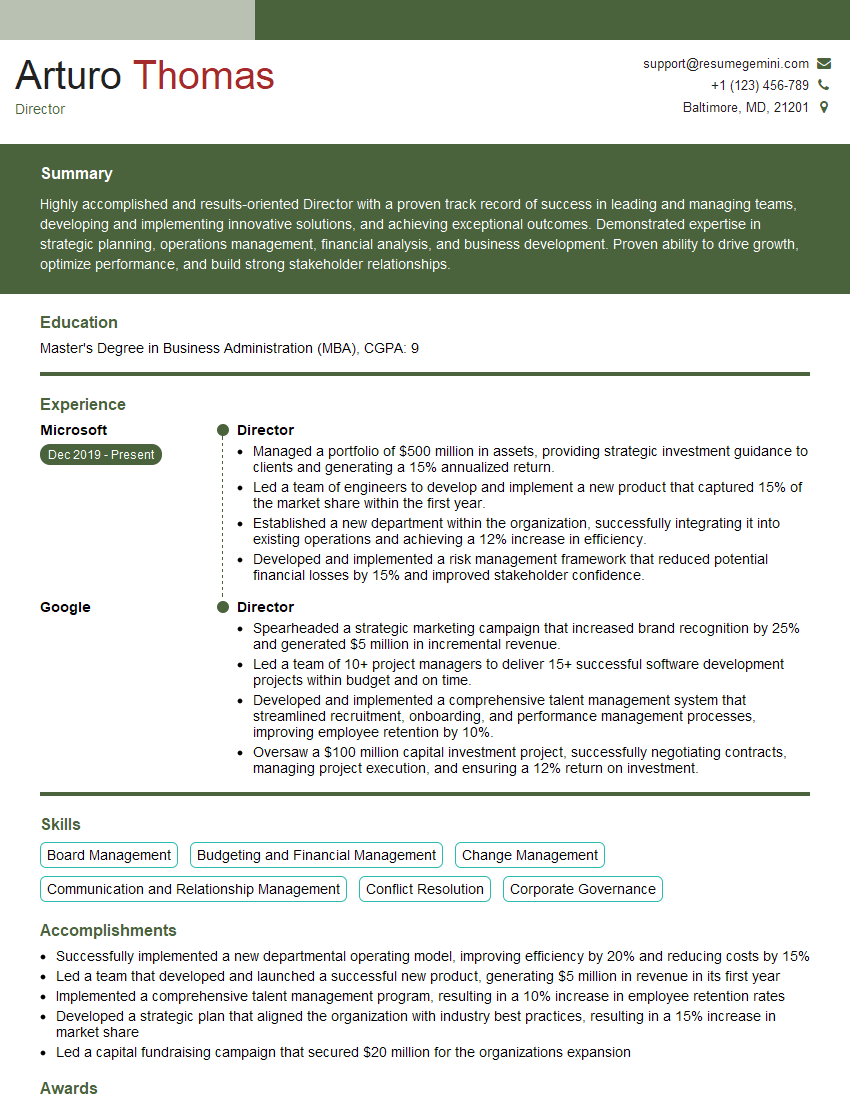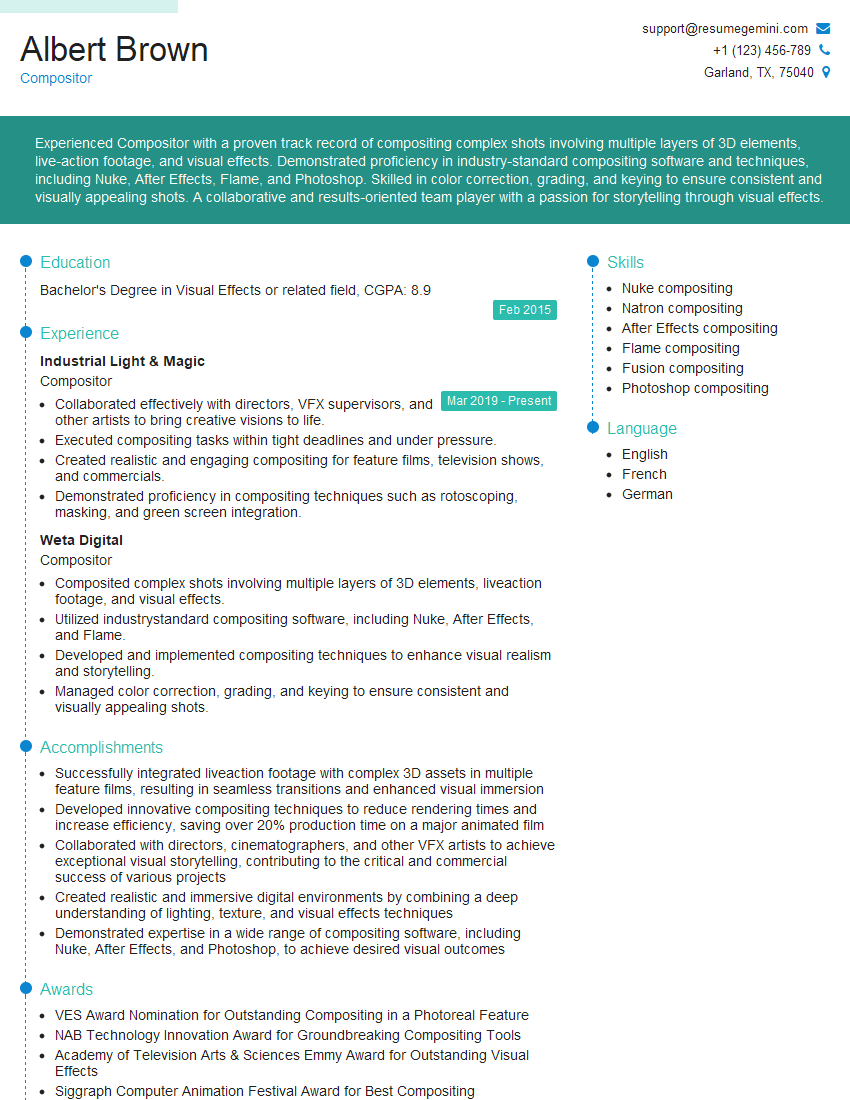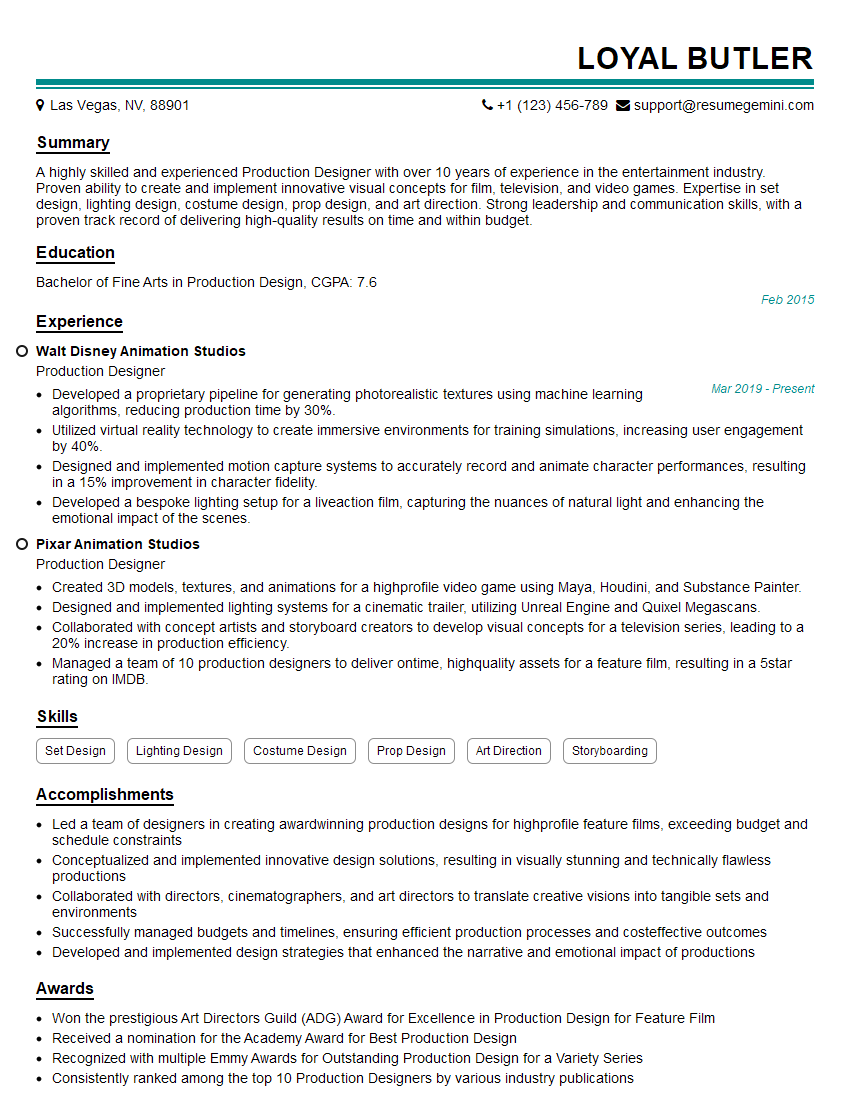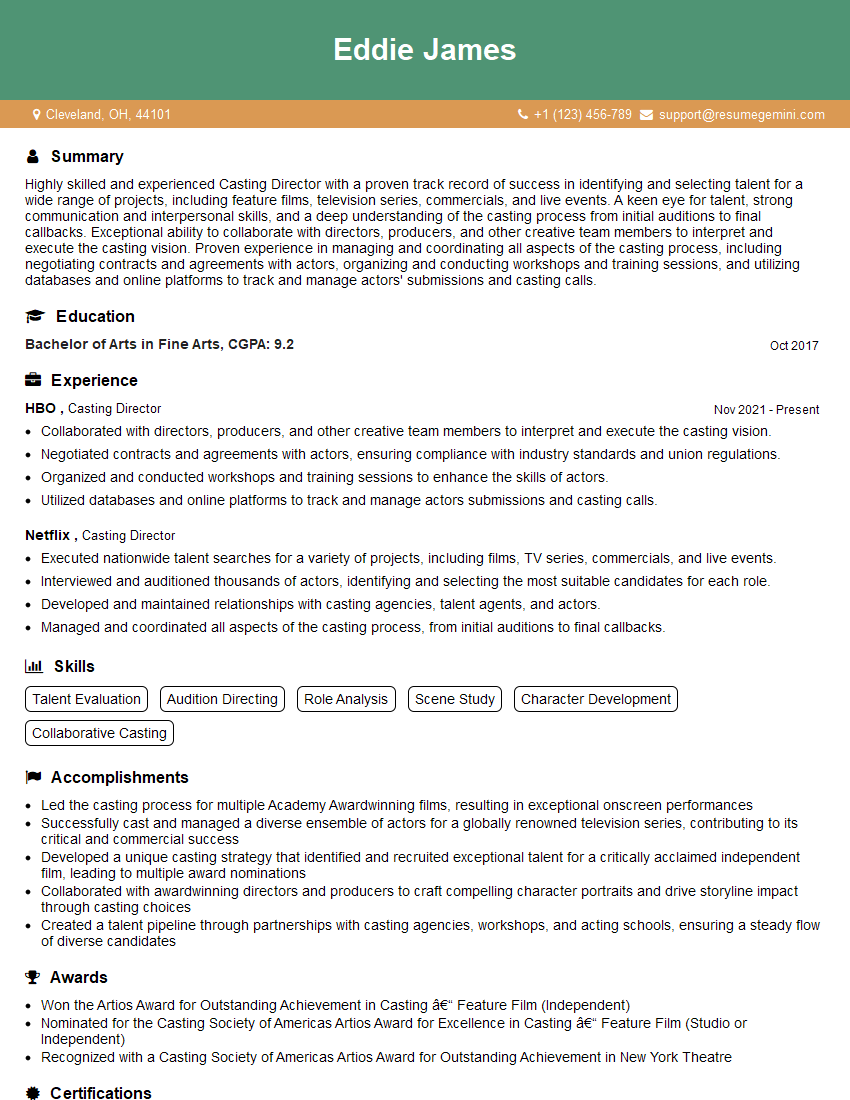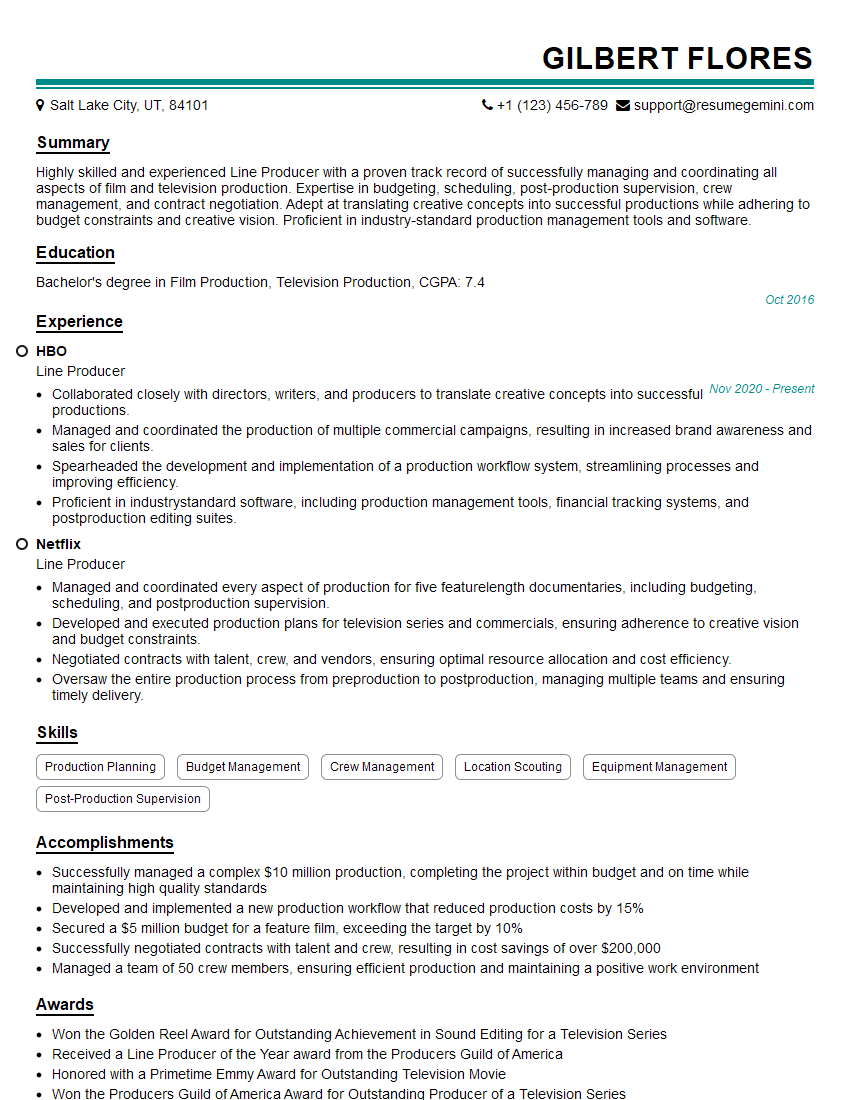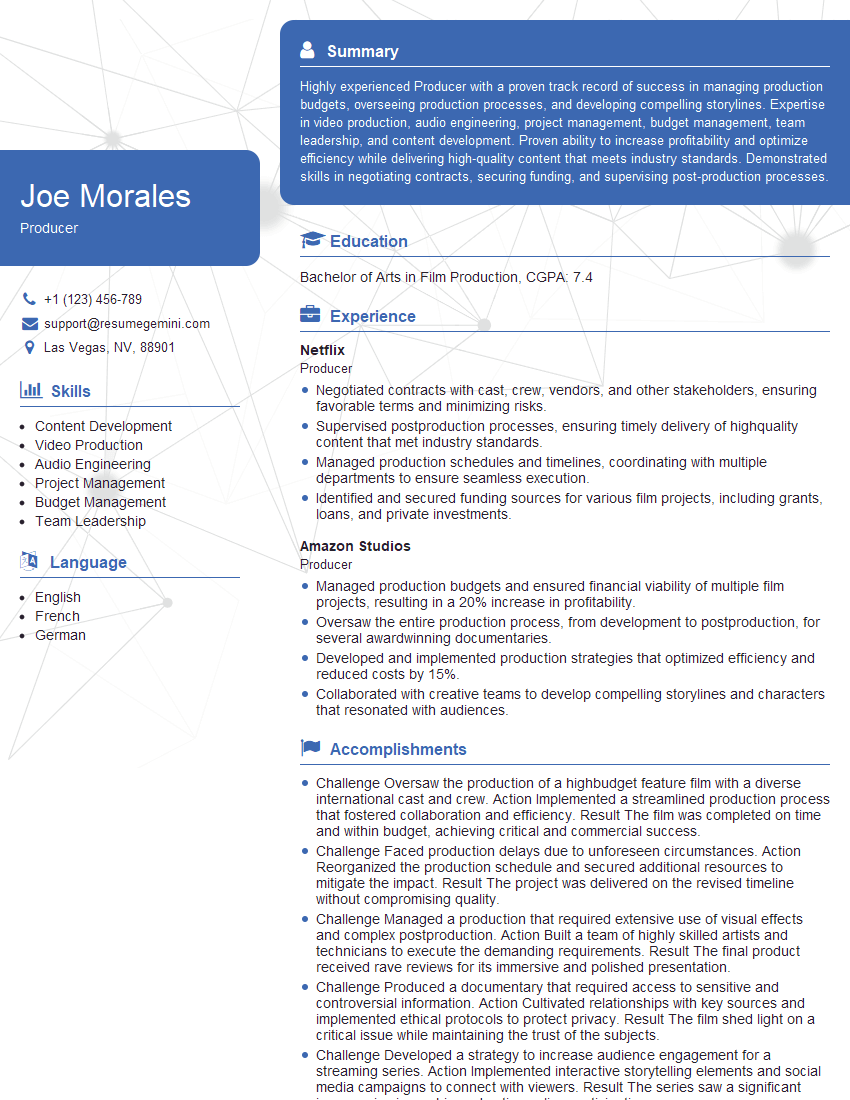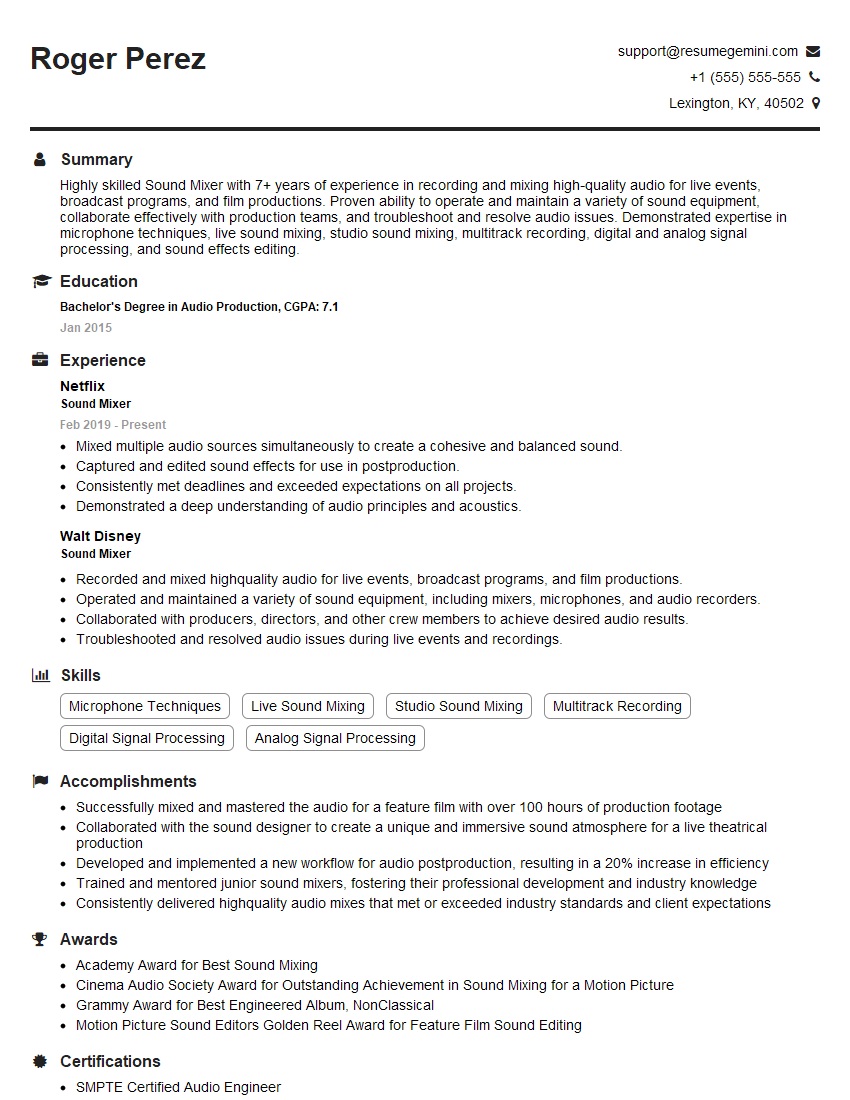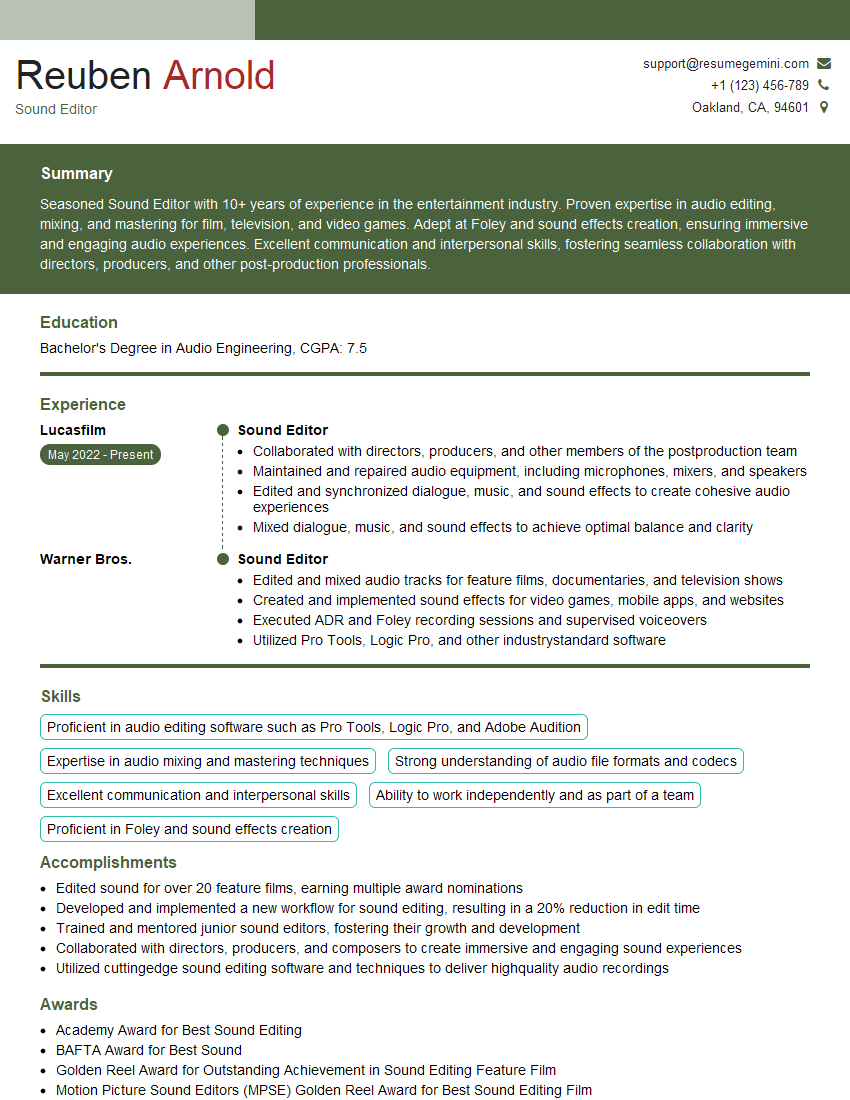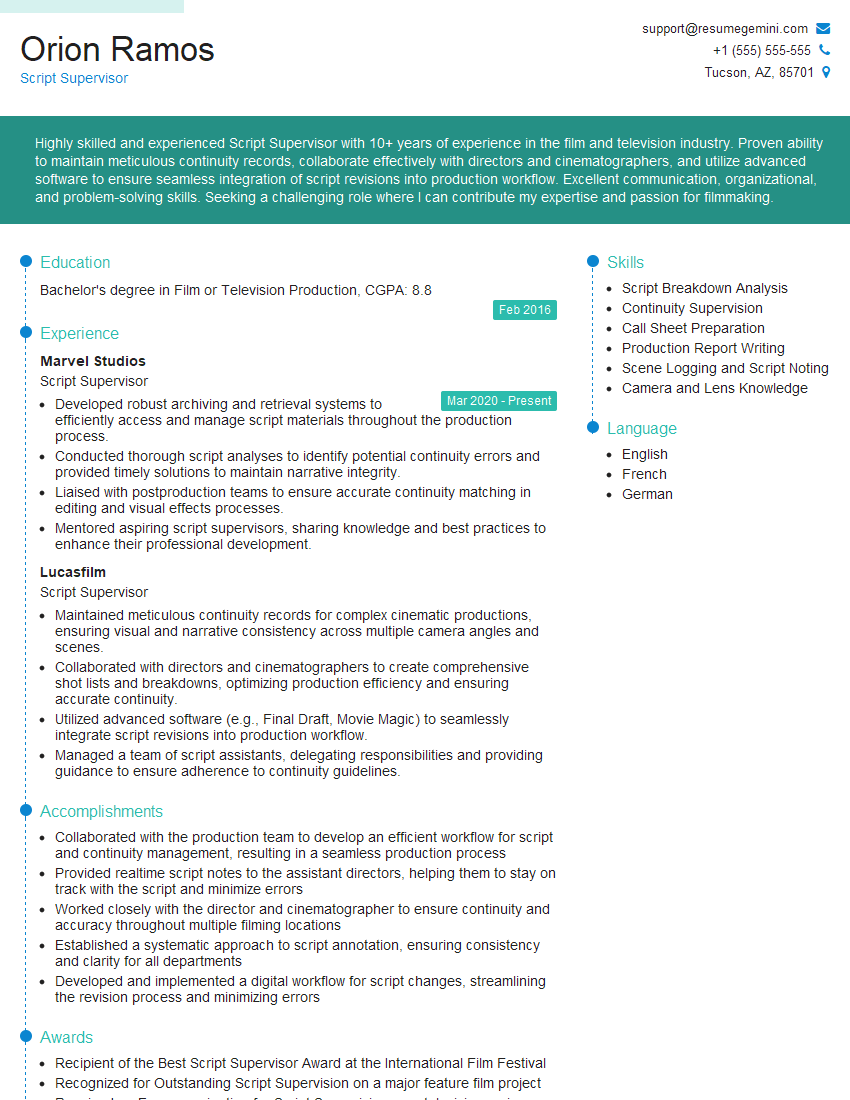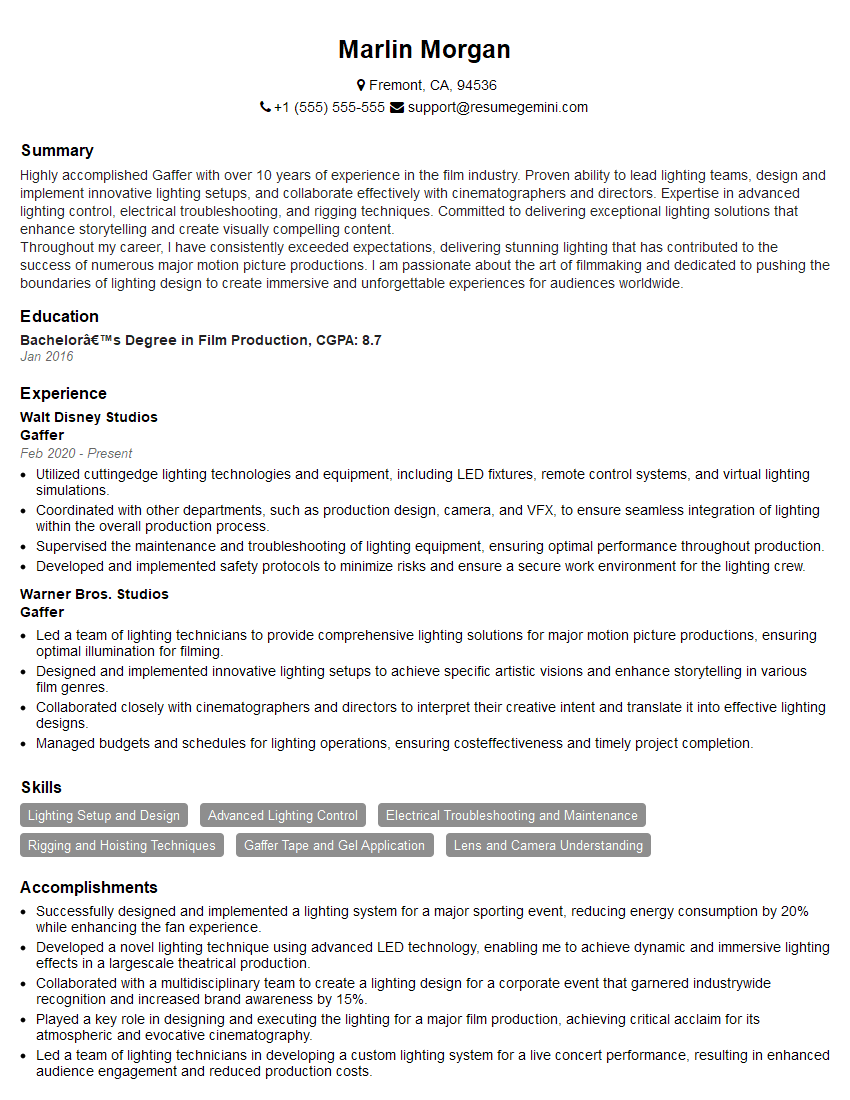Preparation is the key to success in any interview. In this post, we’ll explore crucial Independent Film Production interview questions and equip you with strategies to craft impactful answers. Whether you’re a beginner or a pro, these tips will elevate your preparation.
Questions Asked in Independent Film Production Interview
Q 1. Explain your experience with budgeting and resource allocation in independent film production.
Budgeting in independent film is a delicate dance between creative ambition and financial reality. It’s not just about adding up costs; it’s about strategically allocating resources to maximize impact. My approach starts with a detailed breakdown of all anticipated expenses, categorized into pre-production, production, and post-production. Pre-production includes script development, location scouting, casting, and crew hiring. Production covers filming, equipment rentals, permits, and catering. Post-production encompasses editing, sound design, visual effects, music composition, and color grading.
I utilize budgeting software like Celtx or spreadsheets to track every expense, from minor supplies to major equipment rentals. Contingency funds are crucial – typically 10-20% of the total budget – to account for unforeseen issues. I constantly review and revise the budget throughout the process, making informed decisions about where to prioritize spending and where potential savings might be found without compromising the film’s vision.
For example, on my last project, we opted for a smaller crew to reduce labor costs, but we invested more in high-quality equipment rentals to ensure superior visuals. This strategic allocation allowed us to maintain creative integrity while staying within budget. This required close collaboration with the Director of Photography (DP) to find creative solutions within our constraints.
Q 2. Describe your approach to scheduling and managing a film shoot under tight deadlines.
Scheduling on a low-budget independent film is all about efficiency and flexibility. My approach involves creating a detailed shot list that considers location availability, actor schedules, and crew availability. I use scheduling software like ShotGrid to create a visual representation of the shoot, which allows for easy identification and management of potential conflicts. This shot list is then used to construct a comprehensive shooting schedule, meticulously outlining each day’s filming activities.
Working under tight deadlines requires a proactive approach. I prepare detailed pre-production plans, conduct thorough rehearsals, and ensure all equipment is tested and ready to go. Contingency plans are crucial, accounting for potential delays due to weather, equipment malfunctions, or actor unavailability. On set, communication is paramount; I make sure the crew knows the daily plan, potential roadblocks and expectations to keep things running smoothly and efficiently. This is where experience in managing crews becomes vital. Communication and preparedness are key to working efficiently and overcoming inevitable challenges.
On my last short film, we faced unexpected weather delays. However, our detailed schedule allowed us to quickly re-prioritize shots, making use of indoor locations to complete the filming on schedule, minimizing any major setbacks.
Q 3. How do you handle conflicts between creative vision and budgetary constraints?
The creative vision and budgetary constraints are often at odds in independent filmmaking. My approach is one of creative problem-solving and compromise, aiming to find innovative solutions that maintain the film’s artistic integrity within the financial limitations. Open and honest communication between the director, producers, and other key creative personnel is critical to navigate these challenges.
For example, if the director desires a specific expensive location, we may explore alternative locations that offer similar aesthetic qualities but at a lower cost. Similarly, if a specific type of camera equipment is beyond our budget, we may research more affordable alternatives that still achieve the desired visual effect. Sometimes, even minor adjustments in the script, such as reducing the number of locations, can significantly reduce production costs. Finding these cost-effective alternatives without sacrificing the creative heart of the film is a key skill in independent film production.
I see it as a puzzle where every piece matters. We brainstorm solutions together, constantly evaluating the impact of creative choices on the budget and vice versa. This collaborative spirit fosters a solution-oriented atmosphere, ensuring that the final product reflects a balance between artistic vision and fiscal responsibility.
Q 4. What’s your experience with securing funding for independent film projects?
Securing funding for independent film projects requires a multifaceted approach that involves developing a strong project proposal, showcasing a compelling narrative, and building relationships with potential investors and financiers.
My experience involves creating detailed budget proposals, highlighting the film’s potential return on investment (ROI) and presenting the project to various funding sources, including private investors, film grants (e.g., those offered by organizations like the National Endowment for the Arts or state-level arts councils), crowdfunding platforms (e.g., Kickstarter, Indiegogo), and film funds.
A strong pitch deck is crucial. It must showcase a concise yet persuasive synopsis, a director’s vision statement, key creative team members’ bios, a comprehensive budget, and a clear plan for marketing and distribution. Networking is also essential – attending film festivals and industry events helps build relationships with potential investors and financiers. The key is to show that your project not only holds artistic merit but also has a viable business plan.
Q 5. Describe your experience with different shooting styles (e.g., documentary, narrative).
My experience encompasses both narrative and documentary filmmaking, each demanding a unique approach. Narrative filmmaking requires meticulous planning, scripting, and pre-production work to ensure the story unfolds smoothly. This involves managing actors, coordinating locations, and orchestrating the various scenes.
Documentary filmmaking, in contrast, often involves a more flexible approach to production. It requires adaptability, as events may unfold unpredictably during filming. The focus is on capturing real-life events and interviews, demanding a more improvisational style and keen observational skills. I’ve directed both narrative shorts and documentary features, and the core skill remains excellent communication and organizational skills. The style of shooting depends greatly on the narrative style you are trying to achieve. For example, a handheld camera can bring a sense of immediacy to a documentary while a steady-cam might be preferred for a more formal narrative piece.
I find that the core principles of strong storytelling, visual composition, and effective editing apply to both forms. The key difference is the degree of control and pre-planning required.
Q 6. Explain your knowledge of various camera systems and their applications in filmmaking.
My familiarity with camera systems ranges from traditional film cameras to modern digital cinema cameras. I have experience using various formats, including Super 35, full-frame sensors, and even smaller sensor cameras like those on DSLRs and mirrorless cameras for specific applications.
Understanding the strengths and limitations of each system is crucial. For example, a large-format sensor like Arri Alexa LF provides incredible dynamic range and resolution, perfect for high-end features. However, it comes with a higher cost and greater technical complexity. Smaller sensor cameras offer affordability and flexibility, making them suitable for lower-budget productions or specific creative shots that need particular lenses and configurations. I also have extensive experience with various lenses, from wide-angle to telephoto, and understand how lens choices impact the overall aesthetic and narrative of the film.
Choosing the right camera system is dependent upon the project’s budget, the desired look, the shooting style, and the post-production workflow. I always prioritize selecting the most appropriate system to meet the creative demands of the film, ensuring both artistic success and effective resource utilization.
Q 7. How do you manage a film crew effectively and foster a collaborative environment?
Managing a film crew effectively requires a blend of strong leadership, clear communication, and fostering a collaborative environment. It starts with careful crew selection, assembling a team of skilled and reliable individuals who are not only proficient in their respective roles but also demonstrate a positive attitude and willingness to work collaboratively.
I ensure clear communication through daily production meetings, regular updates, and open channels for feedback. I strive to create a respectful and supportive atmosphere on set, where team members feel comfortable contributing ideas and raising concerns. This includes addressing conflicts promptly and fairly, ensuring everyone feels valued and heard. Delegation of tasks is crucial – I empower crew members to take ownership of their responsibilities, fostering a sense of accountability and team cohesion. Finally, I believe in celebrating successes and acknowledging individual contributions to maintain team morale and motivation.
I often use a combination of direct communication, email updates, and even collaborative online tools to streamline communication. Positive leadership builds a respectful and productive set atmosphere, leading to a collaborative effort that creates a successful end product.
Q 8. What are your preferred post-production workflows and software proficiency?
My post-production workflow centers around efficiency and collaboration. I prefer a non-linear editing system, primarily Adobe Premiere Pro, for its flexibility and powerful features. My proficiency extends to DaVinci Resolve for color grading, offering a robust and cost-effective solution. For sound, I utilize Audacity for initial cleaning and Pro Tools for advanced mixing and mastering. My workflow typically begins with assembling the footage, followed by a rough cut, then iterative refinement involving color correction, sound design, visual effects (using After Effects when needed), and finally, mastering. I believe in a collaborative approach, regularly sharing dailies and rough cuts with the director and producers to ensure alignment with the creative vision. For example, on my recent project ‘Silent Echoes,’ the director preferred a desaturated color palette to enhance the film’s melancholic tone. This was iteratively achieved in DaVinci Resolve through careful adjustments of the color curves and saturation levels. This collaborative approach ensures we achieve the desired look and feel throughout the post-production process.
Q 9. Describe your experience with collaborating with actors and directors.
Collaborating with actors and directors is crucial for a successful film. I believe in fostering open communication and mutual respect. With actors, I aim to create a safe and supportive environment where they feel comfortable exploring their characters. Pre-production rehearsals are key, allowing them to familiarize themselves with the script and the director’s vision. On set, I maintain clear communication, ensuring everyone understands their roles and responsibilities. With directors, I work closely throughout the entire production process, from script development to post-production. I value their artistic vision and strive to translate it into a visually compelling and coherent film. For example, during the filming of ‘City Lights,’ a short film I produced, the director envisioned a specific emotional arc for the protagonist. We worked closely with the lead actor, using improv sessions during rehearsals to uncover subtle nuances in their performance that truly captured the character’s complexity and ultimately strengthened the narrative.
Q 10. How do you ensure the quality of a film’s sound design and mixing?
Ensuring high-quality sound is paramount. My process begins during pre-production, planning for sound recording with appropriate equipment and techniques. On set, I use a boom operator and lav mics to capture clean dialogue, minimizing background noise. In post-production, I utilize Pro Tools for meticulous cleaning, editing, and mixing. I focus on dialogue clarity, sound effects design to enhance the narrative, and music integration to create the right emotional impact. I regularly employ techniques like noise reduction, equalization, and compression to optimize audio quality. Sound design is more than just clean audio; it’s about crafting an immersive soundscape that enhances the viewer’s experience. For instance, in ‘The Whispering Walls,’ I incorporated subtle ambient sounds and atmospheric effects to build suspense and create a chilling atmosphere. The process involved creating custom sound effects to complement the visual elements and amplify the film’s emotional impact. After a preliminary mix, I conduct test screenings to gather feedback on the overall sound experience before final mastering.
Q 11. Explain your process for storyboarding and shot planning.
Storyboarding and shot planning are critical for efficient and effective filmmaking. I typically begin by analyzing the script, breaking it down into scenes and identifying key moments. I then create detailed storyboards, sketching out each shot’s composition, camera angles, and movement. These visual aids help to conceptualize the film’s visual style and assist in pre-visualization. This process informs shot planning, including camera setup, lighting requirements, and actor blocking. Software like Storyboarder can streamline this process. For example, in my project ‘Beneath the Surface,’ the climax scene required a complex tracking shot. The storyboard helped me pre-visualize the movement, ensuring the smooth camera operation and coordinating with the camera department to execute the shot effectively. Thorough shot planning minimizes wasted time on set and ensures that the final product aligns precisely with the artistic vision. This also significantly reduces the need for costly reshoots and ensures the crew is well prepared for the shoot day.
Q 12. How do you handle unexpected challenges or problems on set?
Unexpected challenges are inevitable on set. My approach centers on problem-solving and adaptability. I maintain open communication with the crew, fostering a collaborative environment where problems can be addressed promptly. For instance, if equipment malfunctions, I have backup plans in place or explore creative solutions using available resources. If an actor is unavailable, I may need to adjust the shooting schedule or find alternative ways to capture the scene. The key is to remain calm, assess the situation rationally, and find a solution that minimizes disruption. During the production of ‘Desert Bloom,’ we experienced a sudden sandstorm that forced us to postpone outdoor shooting. We quickly adapted by rescheduling the affected scenes and utilizing the downtime for indoor shooting and post-production tasks. This approach ensured efficiency without compromising the quality of the film.
Q 13. What are your strategies for marketing and distributing an independent film?
Marketing and distribution for independent films require a strategic approach. This often involves a multi-faceted strategy encompassing online platforms, film festivals, and potentially collaborations with distributors. We build a strong online presence, using social media to generate buzz and engage potential audiences. We create a compelling website and trailer. Submitting to film festivals is critical for gaining exposure, credibility, and potential distribution opportunities. We tailor our submissions based on festival focus and audience. Depending on the film’s scope and budget, we may explore collaborations with distributors or utilize self-distribution platforms such as Vimeo On Demand or other streaming services. For instance, ‘Echoes of Yesterday’ successfully used a targeted social media campaign, alongside film festival submissions which led to a distribution deal with a smaller streaming company. This created a blend of organic and strategic marketing and distribution strategies.
Q 14. Describe your experience with film festivals and submissions.
Film festivals are vital for independent films. My experience involves careful selection of festivals based on their reputation, audience, and alignment with the film’s genre and themes. Submitting requires meticulous preparation, adhering to each festival’s specific guidelines and deadlines. We craft compelling materials, including a synopsis, stills, and a director’s statement, to showcase the film’s qualities. Festivals offer valuable opportunities for networking, feedback, and audience engagement. For instance, ‘The Silent River’ received positive reviews at several international festivals, leading to increased visibility and ultimately, broader distribution through online platforms. This is a testament to the potential of festivals to significantly impact the visibility and success of independent films, ultimately proving their value in launching the career of a film.
Q 15. How familiar are you with legal aspects of film production (e.g., copyright, releases)?
Navigating the legal landscape of film production is crucial. It’s not just about avoiding lawsuits; it’s about protecting your intellectual property and ensuring your project can be distributed effectively. My understanding encompasses several key areas, including copyright, which protects the original expression in your film (not the idea itself), and releases, which are essential for securing permission to use likeness, property, and music.
For instance, copyright infringement could result from using music or footage without proper licensing. This is where meticulous record-keeping and obtaining the correct licenses are paramount. I’m also well-versed in talent releases, location releases, and music releases – all vital documents that safeguard your production from potential legal challenges. I’ve personally managed the acquisition of all these necessary releases on multiple projects, ensuring we stayed compliant with copyright laws and protected the interests of all involved. Understanding these aspects isn’t just about legality; it’s about proactively mitigating risk and preventing costly delays.
Career Expert Tips:
- Ace those interviews! Prepare effectively by reviewing the Top 50 Most Common Interview Questions on ResumeGemini.
- Navigate your job search with confidence! Explore a wide range of Career Tips on ResumeGemini. Learn about common challenges and recommendations to overcome them.
- Craft the perfect resume! Master the Art of Resume Writing with ResumeGemini’s guide. Showcase your unique qualifications and achievements effectively.
- Don’t miss out on holiday savings! Build your dream resume with ResumeGemini’s ATS optimized templates.
Q 16. Explain your experience with pre-production planning and script breakdown.
Pre-production planning is the backbone of a successful film. My approach starts with a thorough script breakdown, a meticulous process of analyzing the script scene by scene to identify every element needed for production: locations, props, costumes, cast, and special effects. I create detailed schedules, budgets, and shooting plans, often using specialized software to streamline the process. For example, I recently worked on a low-budget indie drama where we used a spreadsheet to track every scene’s requirements, which allowed us to identify potential logistical challenges early on and optimize our resources.
This granular approach enables me to create realistic schedules and budgets. The script breakdown informs the creation of a detailed shooting schedule, outlining the order of scenes for maximum efficiency, minimizing location changes, and accounting for actor availability. I’ve found that collaborative pre-production planning sessions, involving key crew members, are invaluable in catching potential problems and fostering team cohesion. A clear and detailed pre-production plan, forged through meticulous script breakdown, is crucial for staying on schedule and within budget.
Q 17. How do you handle risk management in film production?
Risk management in film production is about anticipating potential problems and creating strategies to mitigate them. This involves identifying potential hazards throughout all phases of production: pre-production, production, and post-production. My approach is proactive and multi-faceted.
For instance, weather is a significant risk factor for outdoor shoots. To mitigate this, we might build contingency plans, securing alternative indoor locations or scheduling outdoor scenes based on weather forecasts. Other potential risks include equipment failure, cast or crew injury, and budget overruns. I address these by implementing robust insurance policies, maintaining a well-maintained equipment inventory, creating a safe working environment, and carefully tracking budget spending against projections. Regular progress meetings and open communication with the team are essential to identify and address issues promptly before they escalate into major problems. A strong risk management plan helps keep the project on track, on time, and ultimately successful.
Q 18. What is your understanding of different film formats and their advantages/disadvantages?
Understanding film formats is essential for making informed creative and technical decisions. The choice of format impacts image quality, resolution, storage requirements, and post-production workflow. Common formats include 35mm film, various digital formats (like RED, Arri Alexa, Blackmagic), and even smartphone cameras, each with its own advantages and disadvantages.
- 35mm Film: Offers a unique look and feel, but is expensive, requires specialized processing, and has limited post-production flexibility.
- Digital Formats (e.g., RED, Arri Alexa): Offer high resolution, flexibility in post-production, immediate playback, and easier storage and distribution, but can be significantly more expensive initially compared to smaller cameras.
- Smartphone Cameras: Cost-effective and readily available, offering quick turnaround but can compromise image quality and resolution compared to professional cinema cameras.
The choice depends on the project’s budget, creative vision, and technical requirements. For example, a low-budget project might use a more affordable digital format, while a high-budget feature film might opt for a higher-end cinema camera system or even 35mm for specific aesthetic reasons.
Q 19. Describe your experience with location scouting and securing permits.
Location scouting is crucial for finding visually appealing and practical locations that fit the script’s needs. This involves extensive research, site visits, and negotiations with landowners or property managers. Securing permits for filming involves liaising with local authorities, submitting applications, and adhering to regulations – a process that often requires patience and thorough planning.
On one project, we scouted over a dozen locations before finding the perfect abandoned factory for a key scene. This involved not only assessing the aesthetics but also considering factors like access, parking, safety, and the possibility of securing the necessary permits. Securing permits often involves detailed paperwork, insurance requirements, and potentially paying fees to the local authorities. In my experience, building strong relationships with local officials and communicating clearly about the project is key to obtaining permits efficiently and without complications. I always prioritize responsible location management, aiming to minimize disruption and ensuring the location is left as we found it, or better.
Q 20. How do you ensure a film project stays on track regarding its schedule and budget?
Keeping a film project on schedule and within budget requires meticulous planning, proactive monitoring, and decisive problem-solving. I use a combination of techniques to achieve this: detailed pre-production planning (as mentioned earlier), regular progress reports, and adaptable scheduling. This includes creating a detailed production schedule with built-in buffer time for unforeseen circumstances.
For example, we use Gantt charts to visualize the production timeline and identify potential scheduling conflicts. I also incorporate regular budget reviews and analysis to identify areas where costs might be exceeding projections, allowing for early intervention. Effective communication across the team is also crucial; daily progress meetings help identify and resolve issues promptly before they cause significant delays or cost overruns. By proactively managing both schedule and budget, employing efficient workflows, and adapting to changing circumstances, it is possible to keep a film project both on track and within its financial parameters.
Q 21. Explain your experience in working with different film crews, from small to large.
My experience working with film crews ranges from small, tight-knit teams on micro-budget projects to larger, more complex crews on higher-budget productions. The key to success in either scenario is clear communication, strong leadership, and fostering a collaborative environment.
On smaller crews, I often wear multiple hats, taking on responsibilities beyond my primary role. This requires versatility, adaptability, and a willingness to assist wherever needed. On larger crews, the challenge lies in effective delegation, clear communication, and maintaining consistent workflow across numerous departments. I’ve found that establishing clear roles, responsibilities, and communication channels is essential for managing larger teams and coordinating complex productions. Regardless of the crew size, I emphasize creating a supportive and positive atmosphere where everyone feels valued and empowered to contribute their best work.
Q 22. What is your approach to hiring and managing freelance crew members?
Hiring and managing freelance crew is crucial for independent films, where budgets are often tight. My approach is multifaceted. First, I build a strong network of reliable professionals through past collaborations and industry referrals. I meticulously review portfolios and resumes, focusing on experience relevant to the specific project needs. For example, for a period piece, I’d prioritize candidates with experience in historical set design or wardrobe.
Once a crew member is selected, clear communication is key. I provide detailed job descriptions and expectations upfront, outlining deliverables, timelines, and payment schedules. This transparency prevents misunderstandings and ensures everyone is on the same page.
During the production, I foster a collaborative environment, encouraging open communication and problem-solving. Regular check-ins help address challenges early on, ensuring the project stays on track. I also manage payment processes efficiently and fairly, acknowledging and appreciating their contributions, which helps maintain positive working relationships for future projects.
Q 23. Describe your experience with problem-solving equipment malfunctions on set.
Equipment malfunctions are inevitable on set, especially in independent films where resources are often limited. My approach is proactive and involves several steps. Firstly, thorough pre-production planning includes checking all equipment meticulously before the shoot. This involves testing everything from cameras and lighting to sound equipment.
Secondly, having a well-equipped ‘A’ and ‘B’ camera system or equivalent redundancy for crucial equipment significantly reduces downtime. If a camera fails, we can quickly switch to the backup.
Thirdly, having a skilled, resourceful crew is critical. I always ensure that at least one member of the crew is proficient in basic troubleshooting and repair. For example, on one film, our gaffer’s knowledge of electrical wiring saved us from a major delay. If the problem exceeds our capabilities, we quickly call a qualified technician.
Finally, post-production planning should account for potential technical challenges during shooting. This might involve having extra time allotted for fixing technical issues during the post-production process.
Q 24. What is your process for reviewing dailies (rushes) and providing feedback?
Reviewing dailies (rushes) is a critical part of the filmmaking process. My process involves a dedicated session with the director and key crew members, usually the cinematographer and editor. We watch the footage in a quiet, focused environment, typically at the end of each shooting day.
We assess the footage based on several parameters. We check the technical aspects, such as focus, exposure, and audio quality. We then look at the performance aspects, noting things such as actor delivery, blocking, and pacing. Finally, we check for any story continuity issues.
My feedback is constructive and collaborative, emphasizing both positive aspects and areas needing improvement. I use specific examples from the footage to illustrate my points, helping the director and crew understand the issues effectively and devise solutions for subsequent shooting days. This iterative process ensures the final product aligns closely with the director’s vision and is technically sound.
Q 25. How do you utilize post-production techniques to enhance the storytelling of a film?
Post-production is where the film truly comes to life. I use post-production techniques to enhance storytelling through several methods. Editing, the most fundamental tool, shapes the narrative’s pace and emotional arc. Smart cuts can build tension, create humor, or subtly shift audience perception.
Sound design plays a vital role; it sets the mood, enhances dramatic moments, and clarifies the story. For example, subtle background sounds can add realism, while strategically placed sound effects can amplify suspense or comedic impact. Music underscores the emotions of the film, guiding the viewer through the narrative journey.
Color grading enhances the film’s visual style and mood, and VFX can significantly add realism, create fantastical elements, or even correct minor errors that might have occurred during the shoot. The clever use of all these post-production tools serves to amplify the director’s vision and strengthen the film’s emotional impact on the viewer.
Q 26. Explain your understanding of color correction and grading in post-production.
Color correction and grading are distinct but related post-production processes. Color correction aims to fix technical inconsistencies in the footage, ensuring color balance and accuracy across all shots. This might involve adjusting white balance, correcting exposure issues, or removing color casts. It’s essentially about fixing technical imperfections.
Color grading is a more creative process, influencing the overall look and feel of the film. It involves manipulating color saturation, contrast, and tone to achieve a desired aesthetic, often reflecting the film’s genre or mood. For instance, a thriller might utilize darker, desaturated colors to create a sense of suspense, while a romantic comedy might opt for brighter, more vibrant tones.
Both processes are crucial for achieving a visually consistent and aesthetically pleasing final product. I work closely with a colorist to refine the film’s look, ensuring it complements the narrative and creates the intended emotional impact.
Q 27. Describe your experience with visual effects integration and compositing.
My experience with visual effects (VFX) integration and compositing involves working collaboratively with VFX artists to seamlessly blend computer-generated imagery with live-action footage. This includes providing the artists with high-quality source footage, detailed shot breakdowns, and clear creative direction.
Effective communication is key. I ensure clear communication of the desired visual effects to the VFX team, providing detailed reference materials, storyboards, or animatics if available. Regular feedback sessions are vital, ensuring the VFX work aligns with the film’s overall vision and stylistic approach.
For instance, in one project, we used VFX to create a seamless transition between a real-world location and a digitally created environment. Careful planning and meticulous compositing ensured the transition felt realistic and integrated perfectly into the narrative.
Q 28. How do you ensure the final film meets the director’s creative vision and the producer’s expectations?
Ensuring the final film aligns with both the director’s vision and the producer’s expectations is a delicate balancing act. Open and honest communication is crucial throughout the entire production process. I facilitate regular meetings with both the director and producer, presenting progress updates, addressing concerns, and making collaborative decisions.
Early and frequent feedback sessions are important. Showing rough cuts and test screenings allows for early adjustments and avoids costly rework at later stages.
The producer’s concerns often relate to budget and schedule, while the director focuses on the creative aspects. I act as a bridge between these two, ensuring both parties are kept informed and involved. I leverage my technical and creative knowledge to offer solutions that address both artistic and logistical challenges, leading to a finished film that satisfies all stakeholders while maintaining creative integrity.
Key Topics to Learn for Independent Film Production Interview
- Film Financing & Budgeting: Understanding sources of funding (grants, crowdfunding, private investment), creating realistic budgets, and managing expenses effectively. Practical application: Developing a budget proposal for a short film, outlining contingency planning.
- Production Scheduling & Logistics: Mastering scheduling software, coordinating crew and equipment, and addressing unforeseen challenges on set. Practical application: Creating a detailed shooting schedule, managing location permits and transportation logistics.
- Crew Management & Collaboration: Building and leading a cohesive team, fostering effective communication, and resolving conflicts constructively. Practical application: Describing strategies for motivating a team under pressure, navigating creative differences.
- Post-Production Workflow: Understanding the editing, sound design, visual effects, and color grading processes. Practical application: Outlining a post-production timeline and collaborating effectively with editors and other post-production specialists.
- Distribution & Marketing Strategies: Exploring distribution channels (film festivals, online platforms, theatrical releases), developing marketing plans, and engaging with target audiences. Practical application: Designing a marketing campaign for a low-budget film, utilizing social media and other online tools effectively.
- Legal & Contractual Aspects: Understanding film rights, intellectual property, and contracts. Practical application: Explaining the importance of obtaining proper releases and adhering to legal requirements during production.
- Risk Management & Problem-Solving: Identifying and mitigating potential risks during production, and developing effective strategies for problem-solving in high-pressure situations. Practical application: Discussing a challenging situation encountered during a past project and how it was resolved.
Next Steps
Mastering Independent Film Production opens doors to exciting and fulfilling careers, offering creative freedom and the chance to shape impactful stories. To maximize your job prospects, building a strong, ATS-friendly resume is crucial. ResumeGemini is a trusted resource that can help you craft a professional and impactful resume, significantly improving your chances of landing your dream job. Examples of resumes tailored specifically to Independent Film Production roles are available to guide you.
Explore more articles
Users Rating of Our Blogs
Share Your Experience
We value your feedback! Please rate our content and share your thoughts (optional).
What Readers Say About Our Blog
Hello,
We found issues with your domain’s email setup that may be sending your messages to spam or blocking them completely. InboxShield Mini shows you how to fix it in minutes — no tech skills required.
Scan your domain now for details: https://inboxshield-mini.com/
— Adam @ InboxShield Mini
Reply STOP to unsubscribe
Hi, are you owner of interviewgemini.com? What if I told you I could help you find extra time in your schedule, reconnect with leads you didn’t even realize you missed, and bring in more “I want to work with you” conversations, without increasing your ad spend or hiring a full-time employee?
All with a flexible, budget-friendly service that could easily pay for itself. Sounds good?
Would it be nice to jump on a quick 10-minute call so I can show you exactly how we make this work?
Best,
Hapei
Marketing Director
Hey, I know you’re the owner of interviewgemini.com. I’ll be quick.
Fundraising for your business is tough and time-consuming. We make it easier by guaranteeing two private investor meetings each month, for six months. No demos, no pitch events – just direct introductions to active investors matched to your startup.
If youR17;re raising, this could help you build real momentum. Want me to send more info?
Hi, I represent an SEO company that specialises in getting you AI citations and higher rankings on Google. I’d like to offer you a 100% free SEO audit for your website. Would you be interested?
Hi, I represent an SEO company that specialises in getting you AI citations and higher rankings on Google. I’d like to offer you a 100% free SEO audit for your website. Would you be interested?
good



